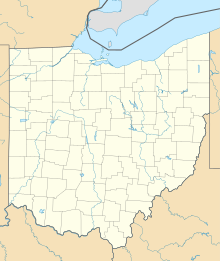SunWatch Indian Village
Coordinates: 39 ° 42 ′ 51.8 " N , 84 ° 14 ′ 13.3" W.
SunWatch Indian Village or completely SunWatch Indian Village / Archaeological Park is a rebuilt village on the Great Miami River in Dayton in the US state of Ohio from around 1300. It is assigned to the Anderson phase within the Fort Ancient culture , its find number is 33 My 127 .
From the first studies to the opening of the park, research facility
The amateur archaeologists John Allman and Charles Smith discovered the first artefacts and began excavations as early as the 1960s. When a construction project was about to begin there, the two contacted James Heilman, the curator for anthropology at the Institute, which was then still called the Dayton Museum of Natural History , because until a few decades ago, Indian history was more likely to be dealt with by natural history . In 1971 an emergency excavation began . The excavation revealed that the village had been inhabited for about two decades and covered around 3 acres . The excavations lasted until 1988 at the place called Incinerator Site at that time . A group of wooden posts found in the center of the village was interpreted as a means of astronomical measurements. Accordingly, the members of the Fort Ancient culture would have had a solar calendar .
In April 1975, the site was entered on the National Register of Historic Places , the national register of historic places. Since significant knowledge about the Fort Ancient culture was gained here, the site was also recognized as a National Historic Landmark in June 1990 under the name Sunwatch Site .
On July 29, 1988, the site was opened to the public. Experimental archeology and an interpretive center serve to research and present the results. The center has been greatly enlarged and reopened in 2006. A garden and planted prairie were created as it existed in the 13th century, plus five houses.
History of the village
The history of the village is usually divided into three phases. In the early phase the village was only inhabited in the northern and southern parts of the later village, and mostly in spring and summer. At that time one of the two center posts was in use, and the houses in the north were built in pairs, in contrast to the scattered structures in the south. There was also a single large house to the west, although it was possibly a little smaller at the time. An inner palisade surrounded these houses.
In the second phase, the artifacts are concentrated in the west and north, so that it is assumed that the founding families lived in the south, whereas a kind of privileged families lived in the west later.
It was only in the third phase that a house built on the model of the Mississippi culture appeared, with ramparts and moats. The house is a red cedar house , so it was built from the wood of the giant tree of life , which is a sign of hierarchization. The outer palisade surrounded all these houses. In addition to the house, the type of burial also indicates influences of the Mississippi culture, as well as the typical proximity of the houses with the greatest prestige to the central cult site, i.e. the stakes, which were probably used for sun observation. The three regions of different development stand at a greater distance from one another, while the groups, which are to be interpreted as social groups, probably families in a broader sense, lived closer to one another. Only a single house in the southwest appears to have had similarly close relationships with both the houses in the west and those in the south. It is probably the oldest house, possibly that of the village founder. Apparently the village grew through its own offspring, but also through immigration.
It was often assumed that the Fort Ancient culture did not have a hierarchy of rank, as it is concise in the Mississippi culture. But even within this culture there were hierarchical differences that were only less clearly manifested and had to be broken down into smaller, less monumental villages. The use of seashells in clay processing and negatively drawn designs show the influence of the Mississippi culture. Suppositions from Robert Cook, for example, suggest that a southern group immigrated and not only brought cultural influence with them, but also soon became the leader of the village, which at that time consisted of 27 huts. This was possibly achieved because this group was the only one able to obtain coveted goods via a long-distance trade network, which in turn could only come from the Mississippi. The new group would have brought with them the distinctive ritualism that spread from the cities of the south to the villages, which revolved primarily around fertility.
Since the chronology of this region of Ohio is still quite unclear in the late woodland period , and therefore the movements between the settlements are difficult to interpret, as well as the question of cultural impact, the site is a specialty and a model for the interpretation of other fort -Ancient sites. However, no excavation can be carried out in 2011.
literature
- Robert A. Cook: SunWatch. Fort Ancient Development in the Mississippian World , University of Alabama Press, Tuscaloosa 2008.
Web links
Remarks
- ↑ James M. Heilman, Roger Hoefer: Possible Astronomical Alignments in a Fort Ancient Settlement at the Incinerator Site in Dayton, Ohio , in: Archaeoastronomy in the Americas 22 (1981) 157-171.
- ^ Incinerator Site on the National Register Information System. National Park Service , accessed February 7, 2020.
- ↑ Listing of National Historic Landmarks by State: Ohio. National Park Service , accessed February 7, 2020.


